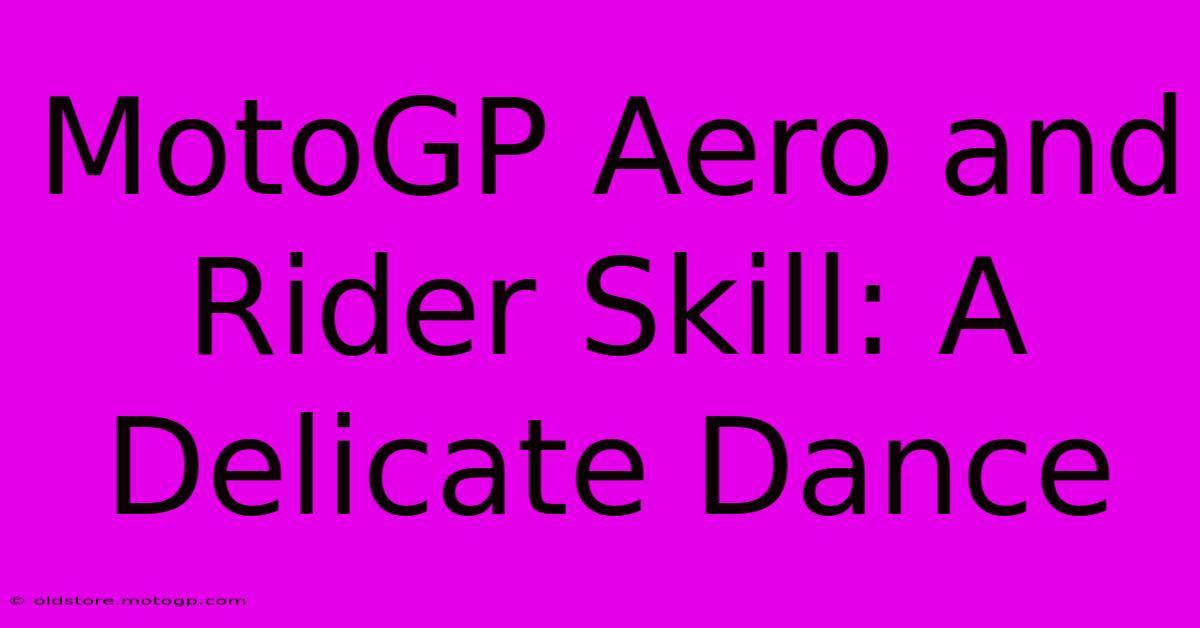MotoGP Aero And Rider Skill: A Delicate Dance

Table of Contents
MotoGP Aero and Rider Skill: A Delicate Dance
MotoGP racing, at its heart, is a breathtaking ballet of speed, precision, and daring. But beyond the raw horsepower and the breathtaking cornering speeds lies a crucial, often overlooked element: aerodynamics. The intricate interplay between a bike's aerodynamic package and the rider's skill is a delicate dance, influencing every aspect of performance, from qualifying lap times to race-day strategy. This intricate relationship is constantly evolving, pushing the boundaries of both engineering and human capability.
The Aerodynamic Advantage: More Than Just Speed
MotoGP bikes are not just fast; they're designed to be aerodynamically efficient. Sophisticated wings, fairings, and winglets are meticulously crafted to generate downforce, crucial for high-speed stability. This downforce allows riders to carry more speed through corners, reducing braking distances and enabling them to accelerate earlier out of turns. The benefits are clear:
- Improved Cornering Speed: Increased downforce keeps the tires firmly planted, allowing for later braking and faster corner exit speeds. This translates directly to faster lap times.
- Enhanced Stability: At MotoGP speeds, stability is paramount. Aerodynamics help to mitigate the destabilizing effects of high wind gusts and turbulence.
- Reduced Wheel Lift: High speeds can cause the front wheel to lift, compromising control. Aerodynamic designs help to prevent this, enhancing rider safety.
The Evolution of MotoGP Aerodynamics
The development of aerodynamic aids in MotoGP has been a fascinating journey. Early iterations were simple, focused primarily on reducing drag. However, the current generation of aerodynamic packages is far more sophisticated, incorporating intricate winglets and carefully sculpted fairings designed to maximize downforce while minimizing drag. This constant push for refinement demonstrates the ever-increasing importance of aerodynamics in MotoGP competition.
The Rider's Role: Mastering the Machine
While aerodynamics play a vital role, they are only half the equation. The rider's skill is equally crucial in harnessing the power of these aerodynamic forces. A rider needs exceptional precision and feel to effectively control a bike that is generating significant downforce, especially at the limit of grip.
- Precise Body Positioning: A rider's posture significantly affects the bike's aerodynamic performance. Slight adjustments in body position can alter downforce distribution and affect stability. Experienced riders are masters of adjusting their position to optimize the bike's handling in different corners.
- Braking and Acceleration Techniques: Aerodynamic performance is intimately tied to braking and acceleration strategies. Riders must precisely manage braking forces to avoid locking up the wheels, and they must smoothly apply throttle to maintain traction and utilize the downforce effectively.
- Adaptability to Changing Conditions: Weather conditions, track temperature, and even tire wear can affect aerodynamic performance. Experienced riders possess the skill and intuition to adapt their riding style and body position to optimize the bike's handling under varying conditions.
The Delicate Balance: Aero and Skill in Harmony
The relationship between aerodynamic performance and rider skill is not simply additive; it's synergistic. A perfectly engineered aerodynamic package is useless without a rider who can expertly control the resulting handling characteristics. Similarly, even the most talented rider will struggle to extract maximum performance from a poorly designed machine. It's the seamless integration of both elements that leads to success.
The Future of Aero in MotoGP
The future of MotoGP aerodynamics promises even more sophistication. Expect to see further refinements in wing designs, potentially incorporating active aerodynamic elements that adjust in real time based on track conditions and rider inputs. This will create an even more complex dance between machine and rider, pushing the boundaries of both engineering and human skill.
Conclusion:
The interplay between MotoGP aerodynamics and rider skill is a dynamic and constantly evolving relationship. It is a testament to the sophisticated engineering that goes into these machines and the incredible talent of the riders who tame them. As technology advances, this delicate dance will continue to fascinate and inspire, shaping the future of motorcycle racing.

Thank you for visiting our website wich cover about MotoGP Aero And Rider Skill: A Delicate Dance. We hope the information provided has been useful to you. Feel free to contact us if you have any questions or need further assistance. See you next time and dont miss to bookmark.
Featured Posts
-
Moto Gp 23 Ps 5 Get In The Drivers Seat
Feb 21, 2025
-
Sting F1 The Future Of Racing
Feb 21, 2025
-
F1 Parking Pass The Secret To A Smooth Race Day
Feb 21, 2025
-
Austin Gp Concert A High Octane Music Experience
Feb 21, 2025
-
Crack The Code Moto Gp Points System Demystified
Feb 21, 2025
